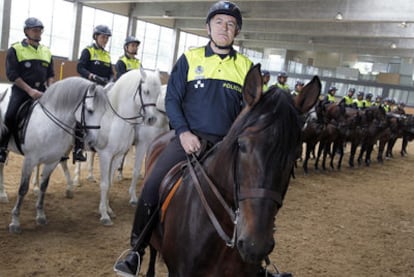"Mounted police give more security"
Squadron patrols the streets and also honors visiting heads of state
"On horseback you have you keep your head up," he says as he sits straight-backed on the steed Airoso while, behind him and at his orders, the Local Police Mounted Squadron move at trot and gallop. Or they pose in formation, to the delight of the schoolchildren who cheer this exhibition from the stands. And this is not just for show: a poor posture can cause back damage in the long run, so you had better do it the right way.
We are at the Squadron's base, near the Puente de los Franceses bridge over the Manzanares river in west-central Madrid. The officer Benedicto Maroto heads the Squadron, formed by 90 people, half of whom work on horseback while the rest take care of logistical and maintenance work, including blacksmiths vets, stable-hands and saddlers. Maroto also heads the Canine Unit, made up of police dogs trained to detect drugs and explosives. "Dappled, chestnut, sorrel, there are three layers," says Maroto, proudly showing the horsehair standard in the three tones commonest in the Squadron. "The ideal is for them to be of the pure Spanish breed, which trains easily and is all-purpose, unlike the Arab breed or Portuguese horses. It suits our street duties and protocol functions alike."
Their functions include vigilance in the Three Kings parade, religious processions and festivals such as the May 2 holiday, and state protocol services: "The presentation of a new ambassador's credentials, or the visits of heads of state. In the recent visit of the Sheikh of Qatar, part of the Squadron was at the City Hall for the reception."
But they also, and increasingly, perform ordinary police service. "It has been decided," Maroto explains, "that we are going to be less for ceremonies and more for horseback patrolling." The Squadron handles central Madrid, and now the newly-inaugurated park strip along the river. "The reason for mounted police in central Madrid is security, and image. A rider on a horse gives the citizen a greater feeling of security than a policeman on foot. People like mounted police; they come up to you to ask questions. Besides, the mounted man is up there, in a better position to see and be seen."
There are some drawbacks. "The city street is not where horses are normally used; they are more for parks and green spaces. We have adapted by using special rubber horseshoes for pavement. For example, going up the Calle Arenal (re-paved a few years ago with smooth stone) is a slippery ride; the horse is always losing his footing." And then, a horse doesn't ask your leave to go to the bathroom before doing his business."Sometimes you get to the Puerta del Sol, he dumps it there, and you have to call the cleanup service."
A horse needs to be highly trained for urban work. "Sudden noises such as an unmuffled motorcycle can startle a horse. Our horses are not castrated. This way they are more spirited, but it has its problems. They may smell a mare, and become ungovernable. They need a lot of training."
How do you get to be a mounted policeman? "There are lots of applicants, and we can pick and choose. Someone who is going to be a good rider is easy to spot, from the first day. It's a voluntary assignment, because you don't only patrol. You have other duties: care of the horse, cleaning and training. Here each horse is assigned a rider. This is something the public don't see, when you put on overalls at seven in the morning to work with the horse. You get to know each other fairly well."

Tu suscripción se está usando en otro dispositivo
¿Quieres añadir otro usuario a tu suscripción?
Si continúas leyendo en este dispositivo, no se podrá leer en el otro.
FlechaTu suscripción se está usando en otro dispositivo y solo puedes acceder a EL PAÍS desde un dispositivo a la vez.
Si quieres compartir tu cuenta, cambia tu suscripción a la modalidad Premium, así podrás añadir otro usuario. Cada uno accederá con su propia cuenta de email, lo que os permitirá personalizar vuestra experiencia en EL PAÍS.
¿Tienes una suscripción de empresa? Accede aquí para contratar más cuentas.
En el caso de no saber quién está usando tu cuenta, te recomendamos cambiar tu contraseña aquí.
Si decides continuar compartiendo tu cuenta, este mensaje se mostrará en tu dispositivo y en el de la otra persona que está usando tu cuenta de forma indefinida, afectando a tu experiencia de lectura. Puedes consultar aquí los términos y condiciones de la suscripción digital.
Últimas noticias
Kate Winslet makes her directorial debut: ‘There aren’t more female directors because we’re busy raising children’
ChatGPT fails the test: This is how it endangers the lives of minors
The late consecration of women artists in their 90s
The Florida Keys tourist paradise is besieged by immigration agents: ‘We’ve never seen anything like this’
Most viewed
- Families demand repatriation of bodies of Colombians who died in Ukraine: ‘This war is a slaughterhouse for foreigners’
- The low-cost creative revolution: How technology is making art accessible to everyone
- Liset Menéndez de la Prida, neuroscientist: ‘It’s not normal to constantly seek pleasure; it’s important to be bored, to be calm’
- Christian Louboutin: ‘Young people don’t want to be like their parents. And if their parents wear sneakers, they’re going to look for something else’
- ‘El Limones’ and the growing union disguise of Mexican organized crime








































